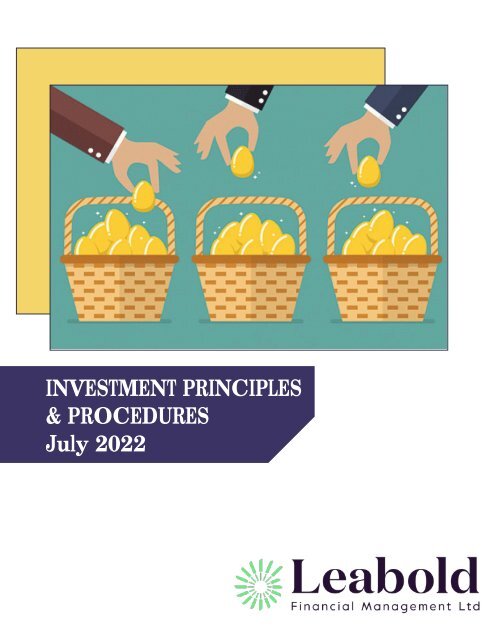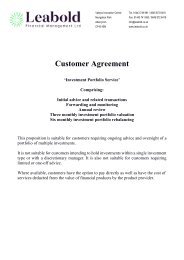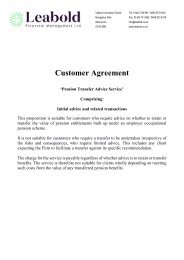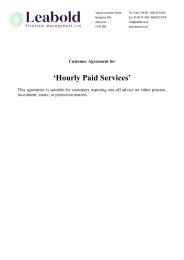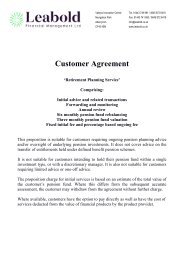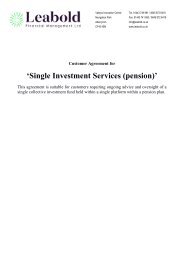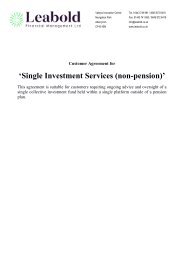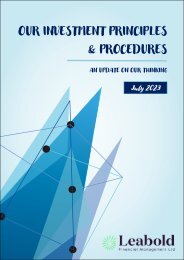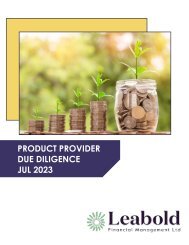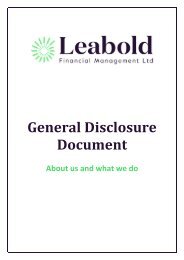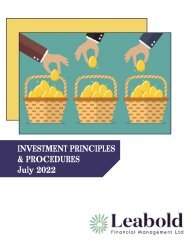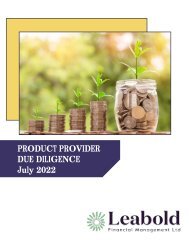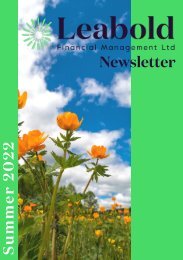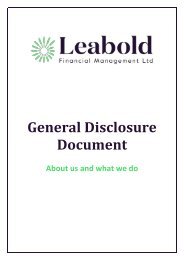Create successful ePaper yourself
Turn your PDF publications into a flip-book with our unique Google optimized e-Paper software.
INVESTMENT PRINCIPLES<br />
& PROCEDURES<br />
<strong>July</strong> <strong>2022</strong>
2<br />
TABLE OF CONTENTS<br />
INTRODUCTION ______________________________________________________ 3<br />
Aims <strong>and</strong> objectives _______________________________________________________________ 3<br />
Frequency of review ______________________________________________________________ 3<br />
Changelog ______________________________________________________________________ 3<br />
INVESTMENT OBJECTIVES AND BELIEFS ________________________________ 4<br />
Objectives ______________________________________________________________________ 4<br />
Beliefs _________________________________________________________________________ 4<br />
PFOPTIMISE _________________________________________________________ 5<br />
Aims ___________________________________________________________________________ 5<br />
Historical Data ___________________________________________________________________ 5<br />
Source of Data ___________________________________________________________________ 6<br />
Efficient Frontier __________________________________________________________________ 7<br />
Constraints ______________________________________________________________________ 8<br />
DELIVERING THE INVESTMENT OBJECTIVE ______________________________ 9<br />
The Process _____________________________________________________________________ 9<br />
THE PROCESS ______________________________________________________ 10<br />
1. Establishing the Client’s ‘Attitude to Risk’ Risk Profile _________________________________ 10<br />
2. Establishing the timescale of the investment ________________________________________ 10<br />
3. Determining the maximum volatility tolerance _______________________________________ 11<br />
4. Determining the maximum potential for investment return ______________________________ 12<br />
5. Establishing the Client’s required rate of investment return _____________________________ 13<br />
6. Identifying the Asset Allocation ___________________________________________________ 14<br />
7. Confirming the Active or Passive investment style ____________________________________ 15<br />
8. Confirming the funds selection ___________________________________________________ 16<br />
Fund Selection Criteria __________________________________________________________ 16<br />
The Leabold Shortlist ___________________________________________________________ 18<br />
LIMITATIONS AND RISK ______________________________________________ 34<br />
Non-discretionary investment management ___________________________________________ 34<br />
Modern Portfolio Theory __________________________________________________________ 34<br />
Past Performance _______________________________________________________________ 34<br />
Future Changes _________________________________________________________________ 35<br />
<strong>Investment</strong> Exposure _____________________________________________________________ 35
3<br />
INTRODUCTION<br />
Aims <strong>and</strong> objectives<br />
The <strong>Investment</strong> <strong>Principles</strong> & <strong>Procedures</strong> report has been prepared to outline the principles that<br />
govern our investment recommendations <strong>and</strong> illustrate the procedures of how these investment<br />
principles can be applied in practice.<br />
Frequency of review<br />
This document will be reviewed every six months, or immediately after any significant changes<br />
in the investment approach.<br />
Changelog<br />
Each release will feature comments throughout the document in respect of any changes made<br />
from the previous release.<br />
"An investment in knowledge pays the best interest."<br />
Benjamin Franklin
4<br />
INVESTMENT OBJECTIVES AND BELIEFS<br />
Objectives<br />
Our overarching investment objective is:<br />
<br />
To target <strong>and</strong> achieve an investment return appropriate to a client’s individual requirement,<br />
while ensuring that this does not expose the client to a level of risk in excess of that which<br />
they would feel comfortable in taking.<br />
Changes from previous release:<br />
None.<br />
Beliefs<br />
Despite the evolution of investment theory <strong>and</strong> practice, there is no commonly approved<br />
framework for investors to follow. There is the freedom of belief. Our beliefs, which act as a<br />
guide to support effective delivery of our investment objectives, are as follows:<br />
1. Modern Portfolio Theory (MPT) is the most influential economic theory dealing<br />
with finance <strong>and</strong> investment.<br />
2. The market will return what the market returns.<br />
3. Passive <strong>and</strong> Active investment strategies serve equally important roles in today’s<br />
investment l<strong>and</strong>scape.<br />
4. Governance is in the best interests of all investment recommendations <strong>and</strong> client’s of the<br />
firm.<br />
Changes from previous release:<br />
None.
5<br />
PFOPTIMISE<br />
Aims<br />
pfOptimise is an excel spreadsheet which aims to provide assistance with the calculations of<br />
optimal portfolios; those that offer the maximum possible return for a given level of risk.<br />
Changes from previous release:<br />
None.<br />
Historical Data<br />
pfOptimise uses weekly performance data over a period of 5, 10 <strong>and</strong> 15 years, using the<br />
following <strong>Investment</strong> Association (IA) sectors. With each new version, the dataset will always<br />
reflect these periods, which means it is subject to continual change.<br />
IA UK All Companies - Funds which invest at least 80% of their assets in UK equities which<br />
have a primary objective of achieving capital growth.<br />
IA UK Smaller Companies - Funds which invest at least 80% of their assets in UK equities of<br />
companies which form the bottom 10% by market capitalisation.<br />
IA Global - Funds which invest at least 80% of their assets globally in equities. Funds must be<br />
diversified by geographic region.<br />
IA Global Emerging Markets - Funds which invest 80% or more of their assets in equities from<br />
emerging market countries as defined by the relevant FTSE or MSCI Emerging Markets <strong>and</strong><br />
Frontier indices. The maximum frontier equity exposure is restricted to 20% of the total fund.<br />
IA Europe Excluding UK - Funds which invest at least 80% of their assets in European equities<br />
<strong>and</strong> exclude UK securities.<br />
IA North America - Funds which invest at least 80% of their assets in North American equities.<br />
IA Asia Pacific Excluding Japan - Funds which invest at least 80% of their assets in Asia Pacific<br />
equities <strong>and</strong> exclude Japanese securities.<br />
IA Japan - Funds which invest at least 80% of their assets in Japanese equities.<br />
IA Global Mixed Bond - Funds which invest at least 80% of their assets in fixed interest<br />
securities. All funds which contain more than 80% fixed interest investments are to be classified<br />
under this heading regardless of the fact that they may have more than 80% in a particular<br />
geographic sector, unless that geographic area is the UK or GEM, when the fund should be<br />
classified under the relevant UK (Sterling) or GEM heading. This sector has a wide range of<br />
funds which invest in bonds <strong>and</strong> currencies across geographic area with differing<br />
characteristics.
6<br />
IA Global Emerging Markets Bond - Funds which invest at least 80% of their assets in emerging<br />
market bonds as defined by a recognised Global Emerging Markets Bond index. Funds must<br />
be diversified by geographic region.<br />
IA Sterling Corporate Bond – Funds which invest at least 80% of their assets in Sterling<br />
denominated (or hedged back to Sterling), Triple BBB minus or above corporate bond securities<br />
(as measured by St<strong>and</strong>ard & Poors or an equivalent external rating agency). This excludes<br />
convertibles, preference shares <strong>and</strong> permanent interest bearing shares (PIBs).<br />
IA Sterling Strategic Bond - Funds which invest at least 80% of their assets in Sterling<br />
denominated (or hedged back to Sterling) fixed interest securities. This includes convertibles,<br />
preference shares <strong>and</strong> permanent interest bearing shares (PIBs).<br />
IA Sterling Government Bond - Funds which invest at least 95% of their assets in Sterling<br />
denominated (or hedged back to Sterling) triple AAA rated, government backed securities, with<br />
at least 80% invested in UK government securities (Gilts).<br />
IA Sterling Index Linked Government Bond - Funds which invest at least 95% of their assets in<br />
Sterling denominated (or hedged back to Sterling) triple AAA rated government backed index<br />
linked securities, with at least 80% invested in UK Index Linked Gilts.<br />
IA Property - Funds which predominantly invest in property. In order to invest "predominantly"<br />
in property, funds should either: invest at least 60% of their assets directly in property; or invest<br />
at least 80% of their assets in property securities; or when their direct property holdings fall<br />
below the 60% threshold for a period of more than 6 months, invest sufficient of the balance of<br />
their assets in property securities to ensure that at least 80% of the fund is invested in property,<br />
whereupon it becomes a hybrid fund.<br />
IA Technology <strong>and</strong> Telecommunications - Funds which invest the majority of their assets in the<br />
technology <strong>and</strong> telecommunications sectors.<br />
IA Money Market - Funds which invest their assets in money market instruments <strong>and</strong> comply<br />
with the definition of a ‘Money Market’ fund set out in the COLL Sourcebook.<br />
Changes from previous release:<br />
IA have changed the name of IA Global Fixed Interest to IA Global Mixed Bond<br />
Source of Data<br />
FE Analytics is used to supply pfOptimise with the data required to support the calculations.<br />
This is due to the quality, comprehensiveness <strong>and</strong> ease of access to the required data.<br />
Changes from previous release:<br />
None.
7<br />
Efficient Frontier<br />
Every combination of asset types (as per those chosen above) can be plotted on a graph, with<br />
the portfolio's risk on the X-axis <strong>and</strong> the average return on the Y-axis. pfOptimise analyses<br />
these combinations <strong>and</strong> creates a curve that connects the most efficient portfolio combinations<br />
– known as the ‘Efficient Frontier’. As each new version is updated with the latest data, the<br />
‘Efficient Frontier’ changes (please see below):<br />
<strong>July</strong> <strong>2022</strong><br />
April <strong>2022</strong><br />
Changes from previous release:<br />
Updated charts.
8<br />
Constraints<br />
We have constrained the ‘Efficient Frontier’ created by pfOptimise, by applying the following<br />
lower <strong>and</strong> upper constraints:<br />
ASSET TYPE<br />
LOWER<br />
UPPER<br />
CONSTRAINT CONSTRAINT<br />
UK Equity 6% 40%<br />
UK Smaller Companies Equity 0% 4%<br />
Global Equity 0% 12%<br />
Global Emerging Markets Equity 0% 6%<br />
European Equity 6% 12%<br />
North American Equity 6% 14%<br />
Asia Pacific Ex-Japan Equity 6% 10%<br />
Japanese Equity 0% 6%<br />
Global Fixed Interest 0% 14%<br />
Global Emerging Markets Fixed Interest 0% 0%<br />
UK Corporate Bond 4% 22%<br />
UK Strategic Bond 0% 6%<br />
UK Government Bond 0% 20%<br />
UK Index Linked Bond 0% 8%<br />
Property 0% 8%<br />
Technology & Telecommunications 0% 0%<br />
Cash 0% 75%<br />
This is because:<br />
<br />
<br />
<br />
<br />
<br />
Some of the most optimal portfolios contain a significantly reduced diversification of asset<br />
types, directly opposing our investment beliefs.<br />
By forcing pfOptimise to include a range of different asset types by adding a minimum<br />
constraint greater than zero i.e. equities <strong>and</strong> fixed interest, this reduces the exposure to<br />
volatility <strong>and</strong> potential loss arising from any single asset type.<br />
By forcing pfOptimise to include a range of different geographic locations by adding a<br />
minimum constraint greater than zero i.e. Europe, North America, <strong>and</strong> Asia, this reduces<br />
the exposure to volatility <strong>and</strong> potential loss arising from any particular geographic location<br />
type i.e. solely investing in UK based asset types.<br />
By forcing pfOptimise to obey upper constraints, this ensures that exposure to a particular<br />
asset class or geographic location is not excessive.<br />
Technology & Telecommunications <strong>and</strong> Global Emerging Markets Fixed Interest have<br />
upper constraints set at 0%. This is because any advantages gained as far as diversification<br />
would be offset by the lack of suitable fund options.<br />
Changes from previous release:<br />
None
9<br />
DELIVERING THE INVESTMENT OBJECTIVE<br />
The Process<br />
In order to deliver the investment objective, the following process is adhered to in all<br />
circumstances:<br />
1. Establishing the Client’s ‘Attitude to Risk’ Risk Profile<br />
2. Establishing the timescale of the investment<br />
3. Determining the maximum volatility tolerance<br />
4. Determining the maximum potential for investment return<br />
5. Establishing the Client’s required rate of investment return<br />
6. Identifying the Asset Allocation<br />
7. Confirming an Active or Passive investment style<br />
8. Confirming the fund selection<br />
This process will then repeat at each annual client review meeting.<br />
Changes from previous release:<br />
None<br />
"In investing, what is comfortable is rarely profitable."<br />
Robert Arnott
10<br />
THE PROCESS<br />
1. Establishing the Client’s ‘Attitude to Risk’ Risk Profile<br />
We begin by considering the risk profile of the client. This is achieved through two methods<br />
which work in t<strong>and</strong>em:<br />
<br />
<br />
A psychometric questionnaire provided by FE eValue to identify the amount of risk that a<br />
client is prepared to take.<br />
A discussion with the client to discuss risk, its relevance, <strong>and</strong> the conclusions of the<br />
psychometric questionnaire.<br />
Changes from previous release:<br />
None<br />
2. Establishing the timescale of the investment<br />
Next, we consider the length of time over which the investment will be made. This is achieved<br />
through discussions with the client, where the result will fall into the following categories:<br />
<br />
<br />
<br />
5 years<br />
10 years<br />
15 years<br />
In circumstances where the investment timescale is likely to be less than 5 years, we are<br />
unlikely to provide investment advice.<br />
In circumstances where the investment timescale is longer than 15 years, “15 years” will be<br />
selected.<br />
Changes from previous release:<br />
None
11<br />
3. Determining the maximum volatility tolerance<br />
Once the Risk Profile <strong>and</strong> timescale have been established, an appropriate asset allocation will<br />
be suggested by the psychometric questionnaire. This is entered into pfOptimise, which<br />
assesses the historic return <strong>and</strong> volatility <strong>and</strong> plots it on the ‘Efficient Frontier’:<br />
ASSET TYPE<br />
EVALUE SUGGESTED<br />
CONTENT<br />
UK EQUITY<br />
UK SMALLER COMPANIES EQUITY<br />
35%<br />
0%<br />
GLOBAL EQUITY 25%<br />
GLOBAL EMERGING MARKETS EQUITY 0%<br />
EUROPEAN EQUITY 0%<br />
NORTH AMERICAN EQUITY 0%<br />
ASIA PACIFIC EX-JAPAN EQUITY 0%<br />
JAPANESE EQUITY 0%<br />
GLOBAL FIXED INTEREST 0%<br />
GLOBAL EMERGING MARKETS FIXED INTEREST 0%<br />
UK CORPORATE BOND 30%<br />
UK STRATEGIC BOND 0%<br />
UK GOVERNMENT BOND 0%<br />
UK INDEX LINKED BOND 0%<br />
PROPERTY 10%<br />
TECHNOLOGY & TELECOMMUNICATIONS 0%<br />
CASH 0%<br />
EXPECTED RETURN 5.76%<br />
VOLATILITY 8.83%<br />
RETURN TO RISK RATIO 0.65<br />
Changes from previous release:<br />
None
12<br />
4. Determining the maximum potential for investment return<br />
As the suggested eValue asset allocation has been plotted below the ‘Efficient Frontier’, this<br />
means that the combination of asset types is inefficient. Therefore, using the volatility<br />
percentage as the target, pfOptimise can calculate the optimum combination to achieve the<br />
highest potential investment return while matching the volatility. As below, pfOptimise has<br />
found a combination of asset types that maintains the volatility, but increases the potential<br />
return, thus increasing the Return to Risk Ratio:<br />
ASSET TYPE<br />
EVALUE SUGGESTED<br />
PFOPTIMISE<br />
CONTENT<br />
OPTIMISIATION<br />
UK EQUITY<br />
UK SMALLER COMPANIES EQUITY<br />
35%<br />
0%<br />
6%<br />
4%<br />
GLOBAL EQUITY 25% 12%<br />
GLOBAL EMERGING MARKETS EQUITY 0% 6%<br />
EUROPEAN EQUITY 0% 12%<br />
NORTH AMERICAN EQUITY 0% 10%<br />
ASIA PACIFIC EX-JAPAN EQUITY 0% 10%<br />
JAPANESE EQUITY 0% 2%<br />
GLOBAL FIXED INTEREST 0% 8%<br />
GLOBAL EMERGING MARKETS FIXED<br />
0% 0%<br />
INTEREST UK CORPORATE BOND 30% 4%<br />
UK STRATEGIC BOND 0% 0%<br />
UK GOVERNMENT BOND 0% 18%<br />
UK INDEX LINKED BOND 0% 8%<br />
PROPERTY 10% 0%<br />
TECHNOLOGY & TELECOMMUNICATIONS 0% 0%<br />
CASH 0% 0%<br />
EXPECTED RETURN<br />
VOLATILITY<br />
5.76%<br />
8.83%<br />
7.14%<br />
8.83%<br />
RETURN TO RISK RATIO 0.65 0.81<br />
Changes from previous release:<br />
None
13<br />
5. Establishing the Client’s required rate of investment return<br />
Using our example, the highest potential for future investment growth has been identified to be<br />
7.14% per annum. However, as the required rate of return could be significantly less than this<br />
to achieve a client’s financial objectives <strong>and</strong> goals, targeting this rate of investment return would<br />
exposure the client to excess investment risk.<br />
In order to establish the required rate of return, a mixture of quantitative <strong>and</strong> qualitative research<br />
is undertaken.<br />
<br />
<br />
Qualitative research is used to gain an underst<strong>and</strong>ing of underlying client motivations,<br />
reasons, <strong>and</strong> opinions. This provides valuable insight into the problem <strong>and</strong> helps to develop<br />
ideas for potential quantitative research.<br />
Quantitative research is used to generating numerical outcome data <strong>and</strong> usable statistics.<br />
Cash flow forecasting is the leading tool used to quantify the client’s financial objectives <strong>and</strong><br />
goals. It can quantify <strong>and</strong> rationalise the client attitudes, opinions, behaviors, <strong>and</strong> other<br />
defined variables.<br />
Typical examples of elements that can be targeted:<br />
<br />
<br />
<br />
Providing the potential to offset the effects of future charges, which we would typically<br />
assume to be between 1% <strong>and</strong> 2.5%.<br />
Providing the potential to offset the effects of future inflation, which we typically assume to<br />
be 2% per annum in line with the current Government target.<br />
Providing the potential of achieving a “real” return i.e. a return in excess of charges <strong>and</strong><br />
inflation.<br />
Changes from previous release:<br />
Updated wordings to add clarity. Included some examples to assist with explanation.
14<br />
6. Identifying the Asset Allocation<br />
Once the required rate of return has been established, pfOptimise is used to determine an<br />
optimised combination to achieve the required rate of return. For example, let’s assume that<br />
we identified a need to achieve an investment return of 6% per annum:<br />
ASSET TYPE<br />
EVALUE SUGGESTED<br />
CONTENT<br />
PFOPTIMISE<br />
OPTIMISIATION<br />
UK EQUITY<br />
UK SMALLER COMPANIES EQUITY<br />
35%<br />
0%<br />
6%<br />
4%<br />
GLOBAL EQUITY 25% 2%<br />
GLOBAL EMERGING MARKETS EQUITY 0% 0%<br />
EUROPEAN EQUITY 0% 6%<br />
NORTH AMERICAN EQUITY 0% 0%<br />
ASIA PACIFIC EX-JAPAN EQUITY 0% 10%<br />
JAPANESE EQUITY 0% 0%<br />
GLOBAL FIXED INTEREST 0% 10%<br />
GLOBAL EMERGING MARKETS FIXED<br />
0% 0%<br />
INTEREST UK CORPORATE BOND 0% 12%<br />
UK STRATEGIC BOND 0% 0%<br />
UK GOVERNMENT BOND 30% 20%<br />
UK INDEX LINKED BOND 0% 4%<br />
PROPERTY 0% 18%<br />
TECHNOLOGY & TELECOMMUNICATIONS 10% 8%<br />
CASH 0% 0%<br />
EXPECTED RETURN 5.92% 6.00%<br />
VOLATILITY 8.58% 5.96%<br />
RETURN TO RISK RATIO 0.69 1.01<br />
Changes from previous release:<br />
Visually updated the section to improve readability.
15<br />
7. Confirming the Active or Passive investment style<br />
In order to confirm the investment style, the recommended portfolio is assessed relative to its<br />
position on the ‘Efficient Frontier’ i.e. whether the optimised combination falls to the left or right<br />
of the “Passive vs Active divide” line:<br />
This is because:<br />
<br />
<br />
<br />
<br />
The black cross represents the ‘ideal portfolio’, i.e. the one providing the highest amount of<br />
return for the lowest risk. From this we draw a vertical line that marks our “Passive vs Active<br />
divide”.<br />
As can be seen, the level of risk to which you are exposed increases exponentially in relation<br />
to the amount of return being targeted. Past a certain point (shown on the graph as the<br />
“Passive vs Active divide” line) exposure to capital risk exceeds the amount of return being<br />
targeted.<br />
We believe that ‘active’ management is better to targeted returns that fall to the right of the<br />
‘ideal’ portfolio. This is because ‘active’ fund managers can identify <strong>and</strong> take advantage of<br />
specific investment opportunities to increase the potential for growth. While ‘active’<br />
management costs are higher, we believe that the greater likelihood of achieving the<br />
targeted return justifies the additional expense.<br />
We believe that a ‘passive’ strategy is better suited to targeted returns that fall to the left of<br />
the ‘ideal’ portfolio. This is because we believe that the simple diversification of assets will<br />
be sufficient to achieve the targeted return. As ‘passive’ investing aims to mirror the market,<br />
rather than attempt to beat it with active oversight, the charges are much lower.<br />
Changes from previous release:<br />
None
16<br />
8. Confirming the fund selection<br />
After the asset allocation <strong>and</strong> investment style have been confirmed, individual funds are<br />
selected to fill the desired asset allocation.<br />
Fund Selection Criteria<br />
Funds chosen should adhere as best as possible to the following criteria:<br />
FE Invest’s ‘Approved List’<br />
We give preference to funds that have FE Invest’s ‘Approved List’ status.<br />
Why? We believe that taking into account the expert view of FE Invest (a leading investment<br />
research organization), will greatly improve the quality of funds selected. The FE ‘Approved<br />
List’ is an unbiased selection of funds across a wide range of asset classes <strong>and</strong> geographical<br />
locations, using a uniquely comprehensive suite of ratings, awards, <strong>and</strong> in-depth qualitative<br />
research. The List is continuously reviewed <strong>and</strong> frequently updated, so it remains responsive<br />
to immediate changes.<br />
FE Invest’s Crown Rating<br />
We prefer funds that have a higher FE Invest Crown Rating.<br />
Why? We believe that taking into account the expert view of FE Invest will greatly improve the<br />
quality of funds selected. FE Invest analyse all available factual (quantitative) information on a<br />
fund over the previous three years <strong>and</strong> then provide a rating from one to five Crowns (five being<br />
the highest possible Crown Rating).<br />
FE Invest’s Alpha Manager Rating<br />
We prefer funds that have FE Invest’s Alpha Manager Rating status.<br />
Why? We believe that taking into account the expert view of FE Invest will greatly improve the<br />
quality of funds selected. FE Invest rate the performance of a fund manager over their career,<br />
which includes all funds they have managed <strong>and</strong> the places they have worked. The Rating uses<br />
robust methodology that is designed to distinguish fund managers who have consistently<br />
performed well over the longer term.<br />
Behaviour of the fund in relation to the sector<br />
We give preference to funds that behave similar to the sector.<br />
Why? Our investment belief is that the market will return what the market returns. With this in<br />
mind, we believe that asset allocation will be the driver of long-term performance rather than<br />
fund selection. As such, funds selected should behave similarly to the sector used for our<br />
calculations. If a fund takes on too little or too much risk in relation to the sector, this could have<br />
significant consequences on the accuracy of the asset allocation recommended.
17<br />
Length of track record<br />
We give preference to funds that have longer track records.<br />
Why? Whilst we pay homage to the ubiquitous warning: “Past performance does not guarantee<br />
future results”, we believe that longer track records are a more useful indication to assess the<br />
likelihood of future success. Since funds are often long-term investments, a longer track record<br />
allows us to assess how the fund has behaved in both good <strong>and</strong> bad times, which gives a more<br />
accurate indication of a fund’s true risk profile.<br />
Legal Domicile<br />
We give preference to funds that are legally domiciled in the UK.<br />
Why? Funds domiciled in the UK will benefit from protections such as the Financial<br />
Ombudsman Service (FOS), who settle individual disputes between consumers <strong>and</strong> business<br />
that provide financial services, <strong>and</strong> the Financial Services Compensation Scheme (FSCS),<br />
which is a completely independent <strong>and</strong> free service allowing you to make a claim against a<br />
financial firm that has failed e.g. negligence where you have suffered a financial loss as a result.<br />
Fund Size<br />
We give preference to funds of a larger size.<br />
Why? Typically, the size of a fund does not hinder its ability to meet its investment objectives.<br />
However, larger funds give us greater confidence in the ability of the fund manager to manage<br />
cashflows <strong>and</strong> liquidity risk i.e. that a person is unable to sell their investment. Larger funds<br />
also typically have lower expenses <strong>and</strong> there is less pressure on the fund manager to increase<br />
costs, which can be a small boost to returns.<br />
Changes from previous release:<br />
Minor updates to wordings to improve clarity.
18<br />
The Leabold Shortlist<br />
The Leabold Shortlist is a list of funds that take precedence for fund selection on the basis that<br />
they closely represent the fund selection criteria:<br />
IA UK All Companies<br />
Funds retained on List<br />
<strong>Investment</strong><br />
Style<br />
Fund name<br />
FE Invest<br />
‘Approved List’<br />
FE Invest<br />
‘Crown Rating’<br />
FE Invest ‘Alpha<br />
Manager Rating’<br />
Active Liontrust - Special Situations ♕ ♕ ♕ ♕ ♕ Yes<br />
Active Liontrust - UK Growth Yes ♕ ♕ ♕ ♕ Yes<br />
Passive HSBC - FTSE All Share Index ♕ ♕ ♕<br />
Passive iShares - UK Equity Index (UK) ♕ ♕ ♕ ♕ ♕<br />
Passive L&G - UK Index Yes ♕<br />
Passive ASI - UK All Share Tracker ♕ ♕ ♕ ♕ ♕<br />
Funds added to List<br />
<strong>Investment</strong><br />
Style<br />
Fund name<br />
FE Invest<br />
‘Approved List’<br />
FE Invest<br />
‘Crown Rating’<br />
Passive Royal London - UK Core Equity Tilt ♕ ♕ ♕<br />
FE Invest ‘Alpha<br />
Manager Rating’<br />
Funds removed from List<br />
<strong>Investment</strong><br />
Style<br />
Fund name<br />
Reason<br />
Active AXA - Framlington UK Select Opportunities Fund has deviated from sector behaviour.
19<br />
IA UK Smaller Companies<br />
Funds retained on List<br />
<strong>Investment</strong><br />
Style<br />
Fund name<br />
FE Invest<br />
‘Approved List’<br />
FE Invest<br />
‘Crown Rating’<br />
FE Invest ‘Alpha<br />
Manager Rating’<br />
Active Liontrust - UK Smaller Companies ♕ ♕ ♕ ♕ Yes<br />
Active Invesco - UK Smaller Companies ♕ ♕ ♕<br />
Active BlackRock - UK Smaller Companies ♕ ♕ ♕<br />
Funds added to List<br />
<strong>Investment</strong><br />
Style<br />
Fund name<br />
FE Invest<br />
‘Approved List’<br />
FE Invest<br />
‘Crown Rating’<br />
FE Invest ‘Alpha<br />
Manager Rating’<br />
None at this time<br />
Funds removed from List<br />
<strong>Investment</strong><br />
Style<br />
Fund name<br />
Reason<br />
None at this time
20<br />
IA Global<br />
Funds retained on List<br />
<strong>Investment</strong><br />
Style<br />
Fund name<br />
FE Invest<br />
‘Approved List’<br />
FE Invest<br />
‘Crown Rating’<br />
FE Invest ‘Alpha<br />
Manager Rating’<br />
Active Fidelity - Global Special Situations Yes ♕ ♕ ♕ Yes<br />
Active ASI – Global Equity ♕ ♕ ♕<br />
Passive Vanguard - FTSE Developed World ex-UK Equity Index Yes ♕ ♕ ♕ ♕♕<br />
Passive HSBC - FTSE All World Index ♕ ♕ ♕<br />
Funds added to List<br />
<strong>Investment</strong><br />
Style<br />
Fund name<br />
FE Invest<br />
‘Approved List’<br />
FE Invest<br />
‘Crown Rating’<br />
FE Invest ‘Alpha<br />
Manager Rating’<br />
Active Schroder - Global Equity ♕ ♕ ♕ ♕♕ Yes<br />
Funds removed from List<br />
<strong>Investment</strong><br />
Style<br />
Fund name<br />
None at this time<br />
Reason
21<br />
IA Global Emerging Markets<br />
Funds retained on List<br />
<strong>Investment</strong><br />
Style<br />
Fund name<br />
FE Invest<br />
‘Approved List’<br />
FE Invest<br />
‘Crown Rating’<br />
Active JPM - Emerging Markets Income Yes ♕ ♕ ♕ ♕<br />
FE Invest ‘Alpha<br />
Manager Rating’<br />
Active Schroder - Global Emerging Markets ♕ ♕ ♕<br />
Passive<br />
L&G - Global Emerging Markets Index<br />
Passive iShares - Emerging Markets Equity Index (UK) Yes ♕ ♕ ♕ ♕<br />
Funds added to List<br />
<strong>Investment</strong><br />
Style<br />
Fund name<br />
FE Invest<br />
‘Approved List’<br />
FE Invest<br />
‘Crown Rating’<br />
FE Invest ‘Alpha<br />
Manager Rating’<br />
None at this time<br />
Funds removed from List<br />
<strong>Investment</strong><br />
Style<br />
Fund name<br />
Reason<br />
None at this time
22<br />
IA Europe Excluding UK<br />
Funds retained on List<br />
<strong>Investment</strong><br />
Style<br />
Fund name<br />
FE Invest<br />
‘Approved List’<br />
FE Invest<br />
‘Crown Rating’<br />
Active Fidelity - European Yes ♕ ♕ ♕<br />
FE Invest ‘Alpha<br />
Manager Rating’<br />
Active BlackRock - Continental European Income Yes ♕ ♕ ♕<br />
Active Jupiter - European ♕ ♕ ♕ ♕ Yes<br />
Passive Vanguard - FTSE Developed Europe ex-UK Equity Index Yes ♕ ♕ ♕ ♕ ♕<br />
Passive iShares - Continental European Equity Index ♕ ♕ ♕ ♕<br />
Passive HSBC - European Index Yes ♕ ♕<br />
Funds added to List<br />
<strong>Investment</strong><br />
Style<br />
Fund name<br />
FE Invest<br />
‘Approved List’<br />
FE Invest<br />
‘Crown Rating’<br />
FE Invest ‘Alpha<br />
Manager Rating’<br />
None at this time<br />
Funds removed from List<br />
<strong>Investment</strong><br />
Style<br />
Fund name<br />
Reason<br />
None at this time
23<br />
IA North America<br />
Funds retained on List<br />
<strong>Investment</strong><br />
Style<br />
Fund name<br />
FE Invest<br />
‘Approved List’<br />
FE Invest<br />
‘Crown Rating’<br />
Active Ninety One - American Franchise ♕ ♕ ♕ ♕<br />
FE Invest ‘Alpha<br />
Manager Rating’<br />
Active M&G - North American Dividend Yes ♕ ♕<br />
Active Columbia Threadneedle - American ♕ ♕ ♕<br />
Active Premier Miton - US Opportunities Yes ♕ ♕ Yes<br />
Passive iShares - North American Equity Index (UK) ♕ ♕ ♕<br />
Passive L&G - US Index Trust Yes ♕ ♕ ♕ ♕<br />
Passive HSBC - American Index Yes ♕ ♕ ♕<br />
Funds added to List<br />
<strong>Investment</strong><br />
Style<br />
Fund name<br />
FE Invest<br />
‘Approved List’<br />
FE Invest<br />
‘Crown Rating’<br />
FE Invest ‘Alpha<br />
Manager Rating’<br />
None at this time<br />
Funds removed from List<br />
<strong>Investment</strong><br />
Style<br />
Fund name<br />
Reason<br />
None at this time
24<br />
IA Asia Pacific Excluding Japan<br />
Funds retained on List<br />
<strong>Investment</strong><br />
Style<br />
Fund name<br />
FE Invest<br />
‘Approved List’<br />
FE Invest<br />
‘Crown Rating’<br />
FE Invest ‘Alpha<br />
Manager Rating’<br />
Active FSSA - Asia Focus ♕ ♕ ♕ ♕ Yes<br />
Active Schroder - Asian Alpha Plus Yes ♕ ♕ ♕ ♕<br />
Active Jupiter Asian Income ♕ ♕ ♕ ♕<br />
Passive<br />
Passive<br />
Passive<br />
Royal London - Asia Pacific ex Japan Equity Tilt<br />
iShares - Pacific ex Japan Equity Index (UK)<br />
L&G - Pacific Index Trust<br />
Funds added to List<br />
<strong>Investment</strong><br />
Style<br />
Fund name<br />
FE Invest<br />
‘Approved List’<br />
FE Invest<br />
‘Crown Rating’<br />
FE Invest ‘Alpha<br />
Manager Rating’<br />
None at this time<br />
Funds removed from List<br />
<strong>Investment</strong><br />
Style<br />
Fund name<br />
Reason<br />
None at this time
25<br />
IA Japan<br />
Funds retained on List<br />
<strong>Investment</strong><br />
Style<br />
Fund name<br />
FE Invest<br />
‘Approved List’<br />
FE Invest<br />
‘Crown Rating’<br />
Active Jupiter – Japan Income ♕ ♕ ♕ ♕<br />
FE Invest ‘Alpha<br />
Manager Rating’<br />
Passive HSBC – Japan Index ♕ ♕ ♕ ♕<br />
Passive iShares - Japan Equity Index (UK) ♕ ♕ ♕ ♕<br />
Passive L&G - Japan Index Trust ♕ ♕ ♕ ♕<br />
Funds added to List<br />
<strong>Investment</strong><br />
Style<br />
Fund name<br />
FE Invest<br />
‘Approved List’<br />
FE Invest<br />
‘Crown Rating’<br />
Active Columbia Threadneedle - Japan ♕ ♕ ♕ ♕♕<br />
FE Invest ‘Alpha<br />
Manager Rating’<br />
Funds removed from List<br />
<strong>Investment</strong><br />
Style<br />
Fund name<br />
Reason<br />
Active Baillie Gifford - Japanese Fund replaced with higher quality fund.
26<br />
IA Global Fixed Interest<br />
Funds retained on List<br />
<strong>Investment</strong><br />
Style<br />
Fund name<br />
FE Invest<br />
‘Approved List’<br />
FE Invest<br />
‘Crown Rating’<br />
Active M&G - Global Macro Bond Yes ♕ ♕ ♕<br />
FE Invest ‘Alpha<br />
Manager Rating’<br />
Active Marlborough - Global Bond ♕ ♕<br />
Passive iShares – ESG Overseas Corporate Bond Index (UK) ♕ ♕ ♕<br />
Passive iShares - Overseas Government Bond Index (UK) ♕ ♕ ♕<br />
Funds added to List<br />
<strong>Investment</strong><br />
Style<br />
Fund name<br />
FE Invest<br />
‘Approved List’<br />
FE Invest<br />
‘Crown Rating’<br />
Active Invesco - Global Bond ♕ ♕ ♕ ♕<br />
FE Invest ‘Alpha<br />
Manager Rating’<br />
Funds removed from List<br />
<strong>Investment</strong><br />
Style<br />
Fund name<br />
Reason<br />
None at this time
27<br />
IA Global Emerging Markets Bond<br />
Funds retained on List<br />
<strong>Investment</strong><br />
Style<br />
Fund name<br />
FE Invest<br />
‘Approved List’<br />
FE Invest<br />
‘Crown Rating’<br />
FE Invest ‘Alpha<br />
Manager Rating’<br />
Active M&G - Emerging Markets Bond Yes ♕ ♕ Yes<br />
Active Ninety One - Emerging Markets Blended Debt ♕ ♕ ♕ ♕<br />
Funds added to List<br />
<strong>Investment</strong><br />
Style<br />
Fund name<br />
FE Invest<br />
‘Approved List’<br />
FE Invest<br />
‘Crown Rating’<br />
FE Invest ‘Alpha<br />
Manager Rating’<br />
None at this time<br />
Funds removed from List<br />
<strong>Investment</strong><br />
Style<br />
Fund name<br />
Reason<br />
None at this time
28<br />
IA Sterling Corporate Bond<br />
Funds retained on List<br />
<strong>Investment</strong><br />
Style<br />
Fund name<br />
FE Invest<br />
‘Approved List’<br />
FE Invest<br />
‘Crown Rating’<br />
Active BlackRock - Corporate Bond Yes ♕ ♕ ♕<br />
FE Invest ‘Alpha<br />
Manager Rating’<br />
Active Invesco - Corporate Bond (UK) ♕ ♕ ♕ Yes<br />
Active M&G - Corporate Bond ♕ ♕ ♕ Yes<br />
Active Royal London - Corporate Bond ♕ ♕ ♕ ♕<br />
Passive iShares - Corporate Bond Index (UK) ♕ ♕ ♕ ♕<br />
Funds added to List<br />
<strong>Investment</strong><br />
Style<br />
Fund name<br />
FE Invest<br />
‘Approved List’<br />
FE Invest<br />
‘Crown Rating’<br />
FE Invest ‘Alpha<br />
Manager Rating’<br />
None at this time<br />
Funds removed from List<br />
<strong>Investment</strong><br />
Style<br />
Fund name<br />
Reason<br />
None at this time
29<br />
IA Sterling Strategic Bond<br />
Funds retained on List<br />
<strong>Investment</strong><br />
Style<br />
Fund name<br />
FE Invest<br />
‘Approved List’<br />
FE Invest<br />
‘Crown Rating’<br />
Active Artemis - Strategic Bond ♕ ♕ ♕ ♕<br />
FE Invest ‘Alpha<br />
Manager Rating’<br />
Active Invesco - Tactical Bond (UK) ♕ ♕ ♕ ♕ ♕<br />
Funds added to List<br />
<strong>Investment</strong><br />
Style<br />
Fund name<br />
FE Invest<br />
‘Approved List’<br />
FE Invest<br />
‘Crown Rating’<br />
Active Royal London - Short Duration Credit Yes ♕ ♕<br />
FE Invest ‘Alpha<br />
Manager Rating’<br />
Funds removed from List<br />
<strong>Investment</strong><br />
Style<br />
Fund name<br />
Reason<br />
Active Jupiter - Strategic Bond Fund no longer behaves as per the sector.
30<br />
IA Sterling Government Bond<br />
Funds retained on List<br />
<strong>Investment</strong><br />
Style<br />
Fund name<br />
FE Invest<br />
‘Approved List’<br />
FE Invest<br />
‘Crown Rating’<br />
Active Allianz - Gilt Yield Yes ♕ ♕ ♕ ♕<br />
FE Invest ‘Alpha<br />
Manager Rating’<br />
Active Royal London - UK Government Bond Yes ♕ ♕ ♕ ♕<br />
Active Columbia Threadneedle - UK Fixed Interest ♕ ♕ ♕<br />
Passive L&G - All Stocks Gilt Index Trust ♕ ♕ ♕ ♕<br />
Passive iShares - UK Gilts All Stocks Index (UK) Yes ♕ ♕ ♕<br />
Funds added to List<br />
<strong>Investment</strong><br />
Style<br />
Fund name<br />
FE Invest<br />
‘Approved List’<br />
FE Invest<br />
‘Crown Rating’<br />
FE Invest ‘Alpha<br />
Manager Rating’<br />
None at this time<br />
Funds removed from List<br />
<strong>Investment</strong><br />
Style<br />
Fund name<br />
Reason<br />
None at this time
31<br />
IA Sterling Index Linked Government Bond<br />
Funds retained on List<br />
<strong>Investment</strong><br />
Style<br />
Fund name<br />
FE Invest<br />
‘Approved List’<br />
FE Invest<br />
‘Crown Rating’<br />
Active Royal London - Index Linked Yes ♕ ♕ ♕ ♕<br />
FE Invest ‘Alpha<br />
Manager Rating’<br />
Active AXA - Sterling Index Linked Bond ♕ ♕ ♕<br />
Active M&G - Index-Linked Bond ♕<br />
Passive L&G - All Stocks Index Linked Gilt Index Trust Yes ♕ ♕ ♕ ♕<br />
Passive Vanguard - UK Inflation-Linked Gilt Index Yes ♕ ♕ ♕<br />
Passive iShares - Index Linked Gilt Index (UK) ♕ ♕ ♕<br />
Funds added to List<br />
<strong>Investment</strong><br />
Style<br />
Fund name<br />
FE Invest<br />
‘Approved List’<br />
FE Invest<br />
‘Crown Rating’<br />
FE Invest ‘Alpha<br />
Manager Rating’<br />
None at this time<br />
Funds removed from List<br />
<strong>Investment</strong><br />
Style<br />
Fund name<br />
Reason<br />
None at this time
32<br />
Property<br />
Funds retained on List<br />
<strong>Investment</strong><br />
Style<br />
Fund name<br />
FE Invest<br />
‘Approved List’<br />
FE Invest<br />
‘Crown Rating’<br />
Active Schroder - Global Cities Real Estate Yes ♕ ♕ ♕ ♕<br />
FE Invest ‘Alpha<br />
Manager Rating’<br />
Active BMO - Property Growth & Income ♕ ♕ ♕ ♕ ♕<br />
Passive iShares - Global Property Securities Equity Index (UK) Yes ♕ ♕ ♕ ♕<br />
Funds added to List<br />
<strong>Investment</strong><br />
Style<br />
Fund name<br />
FE Invest<br />
‘Approved List’<br />
FE Invest<br />
‘Crown Rating’<br />
Passive L&G Global Real Estate Dividend Index ♕ ♕<br />
FE Invest ‘Alpha<br />
Manager Rating’<br />
Funds removed from List<br />
<strong>Investment</strong><br />
Style<br />
Fund name<br />
None at this time<br />
Reason
33<br />
Mixed <strong>Investment</strong> (Multi Asset)<br />
Funds retained on List<br />
<strong>Investment</strong><br />
Style<br />
Fund name<br />
FE Invest<br />
‘Approved List’<br />
FE Invest<br />
‘Crown Rating’<br />
Active Fidelity - Multi Asset Open Strategic ♕ ♕ ♕<br />
FE Invest ‘Alpha<br />
Manager Rating’<br />
Active Jupiter - Merlin Income Portfolio ♕ ♕ ♕ ♕ Yes<br />
Active L&G - Mixed <strong>Investment</strong> 0-35% ♕ ♕ ♕ ♕<br />
Active L&G - Mixed <strong>Investment</strong> 20-60% ♕ ♕ ♕<br />
Active McInroy & Wood - Balanced Personal ♕ ♕ ♕ ♕<br />
Active Schroder - Managed Balanced ♕ ♕ ♕<br />
Active TM - UBS (UK) Global Balanced ♕ ♕ ♕<br />
Active Columbia Threadneedle - Managed Bond Focused ♕ ♕ ♕ ♕ ♕<br />
Active Columbia Threadneedle - Managed Equity & Bond ♕ ♕ ♕ ♕ ♕<br />
Active Vanguard - LifeStrategy 20% Equity ♕ ♕ ♕ ♕<br />
Active Vanguard - LifeStrategy 40% Equity ♕ ♕ ♕ ♕<br />
Active Vanguard - LifeStrategy 60% Equity ♕ ♕ ♕<br />
Active Vanguard - LifeStrategy 80% Equity ♕ ♕ ♕ ♕<br />
Funds added to List<br />
<strong>Investment</strong><br />
Style<br />
Fund name<br />
FE Invest<br />
‘Approved List’<br />
FE Invest<br />
‘Crown Rating’<br />
FE Invest ‘Alpha<br />
Manager Rating’<br />
Active Jupiter - Merlin Balanced Portfolio ♕ ♕ ♕ Yes<br />
Active 7IM AAP Moderately Cautious ♕ ♕<br />
Active 7IM AAP Balanced ♕ ♕<br />
Active 7IM AAP Moderately Adventurous ♕ ♕<br />
Funds removed from List<br />
<strong>Investment</strong><br />
Style<br />
Active<br />
Active<br />
Fund name<br />
Liontrust - Sustainable Future Managed<br />
Liontrust - Sustainable Future Cautious Managed<br />
Reason<br />
Fund no longer behaves as per the sector.
34<br />
LIMITATIONS AND RISK<br />
Non-discretionary investment management<br />
As we only offer a non-discretionary investment management service, clients will be advised<br />
on all investment matters. No transactions are carried out without instruction.<br />
Changing to a discretionary investment management service would offer a number of benefits<br />
to clients. It would release them from the burden of making significant investment decisions<br />
<strong>and</strong> would allow the client to focus on other important matters. It would also allow information<br />
that could alter an investment value to be acted on quickly, such as immediately selling a unit<br />
holding. By advising the client, this could mean that an opportunity passes before the instruction<br />
is given.<br />
Modern Portfolio Theory<br />
Modern Portfolio Theory considers many assumptions which are not guaranteed to properly<br />
represent reality. For example, the theory assumes that asset returns are normally distributed<br />
r<strong>and</strong>om variables. A real life examination illustrates this is often far from the truth. In many<br />
cases, there have been large swings which immediately invalidates the theory.<br />
Another flaw in the theory relates to the assumption that all investors have access to the same<br />
information. This is far from true. For example, many online publications charge members to<br />
access their sites. Investors who do not pay an additional fee could be unaware of news that<br />
could significantly influence a potential buy or sell.<br />
Modern Portfolio Theory also assumes investors are rational <strong>and</strong> avoid risk when possible, <strong>and</strong><br />
that there are not large enough investors to influence market prices. However, as the market<br />
includes both irrational <strong>and</strong> risk-seeking investors, <strong>and</strong> large market participants who could<br />
influence market prices, the fundamentals behind Modern Portfolio Theory do not truly<br />
represent reality.<br />
Past Performance<br />
While past performance has been relied on for technical fund analysis, we would reiterate the<br />
view of the Financial Conduct Authority; past performance is not indicative of future returns. We<br />
would therefore avoid quoting details of the past performance of funds as this can create<br />
unrealistic expectations of future performance.
35<br />
Future Charges<br />
The charges levied by the recommended investment funds are not guaranteed. This means<br />
there is a risk they may increase in the future.<br />
<strong>Investment</strong>s can go down as well as up in value. If a withdrawal of capital takes place at a time<br />
of poor stock market performance, the investment may return less than originally paid in.<br />
Future growth may be lower or higher than is necessary for the investment to achieve the<br />
client’s objectives <strong>and</strong> expectations. It is not guaranteed that the client’s objectives will be met.<br />
<strong>Investment</strong> Exposure<br />
A recommended portfolio may include exposure to the property asset class. The purpose is to<br />
provide an efficient means of diversifying risk <strong>and</strong> reducing overall volatility within your portfolio.<br />
However, such funds may need up to 12 months or longer to allow the fund manager time to sell<br />
or reorganise their portfolio. This may prevent you from accessing your capital for up to 12<br />
months following a decision to sell.<br />
A recommended portfolio may include exposure to corporate bonds. Since corporate bonds are<br />
priced on the yield advantage they provide relative to government bonds (widely known as a<br />
“risk-free” asset), any movements in government bond yields have a direct impact on the yields<br />
of corporate issues. As such, corporate bond funds can lose value <strong>and</strong> there is no guarantee that<br />
an investor would receive all of their original capital back.<br />
A recommended portfolio may include exposure to UK Smaller Companies. Whilst this asset<br />
class has significant potential for capital growth over the long term, they carry a significantly<br />
increased volatility than typically found in shares from larger companies. As such, there is the<br />
potential for the value of these funds to change substantially over short periods of time.<br />
A recommended portfolio may include exposure to non-UK investments valued in currencies<br />
other than Sterling. The purpose is to diversify the risk of investing entirely in the UK <strong>and</strong> reduce<br />
overall volatility within your portfolio. However, where the value of the foreign currency falls<br />
relative to Sterling, the Sterling value of the investment may also reduce.


